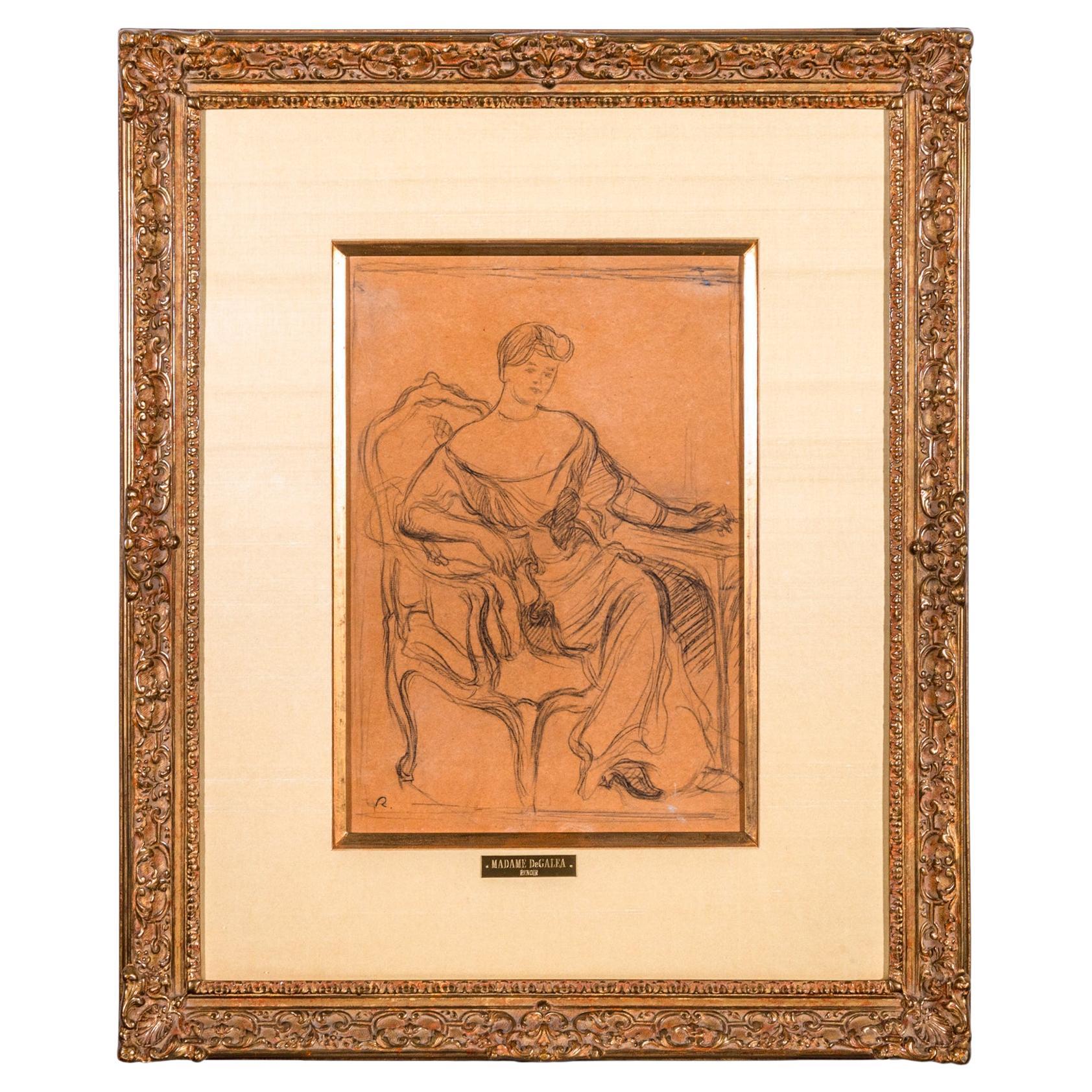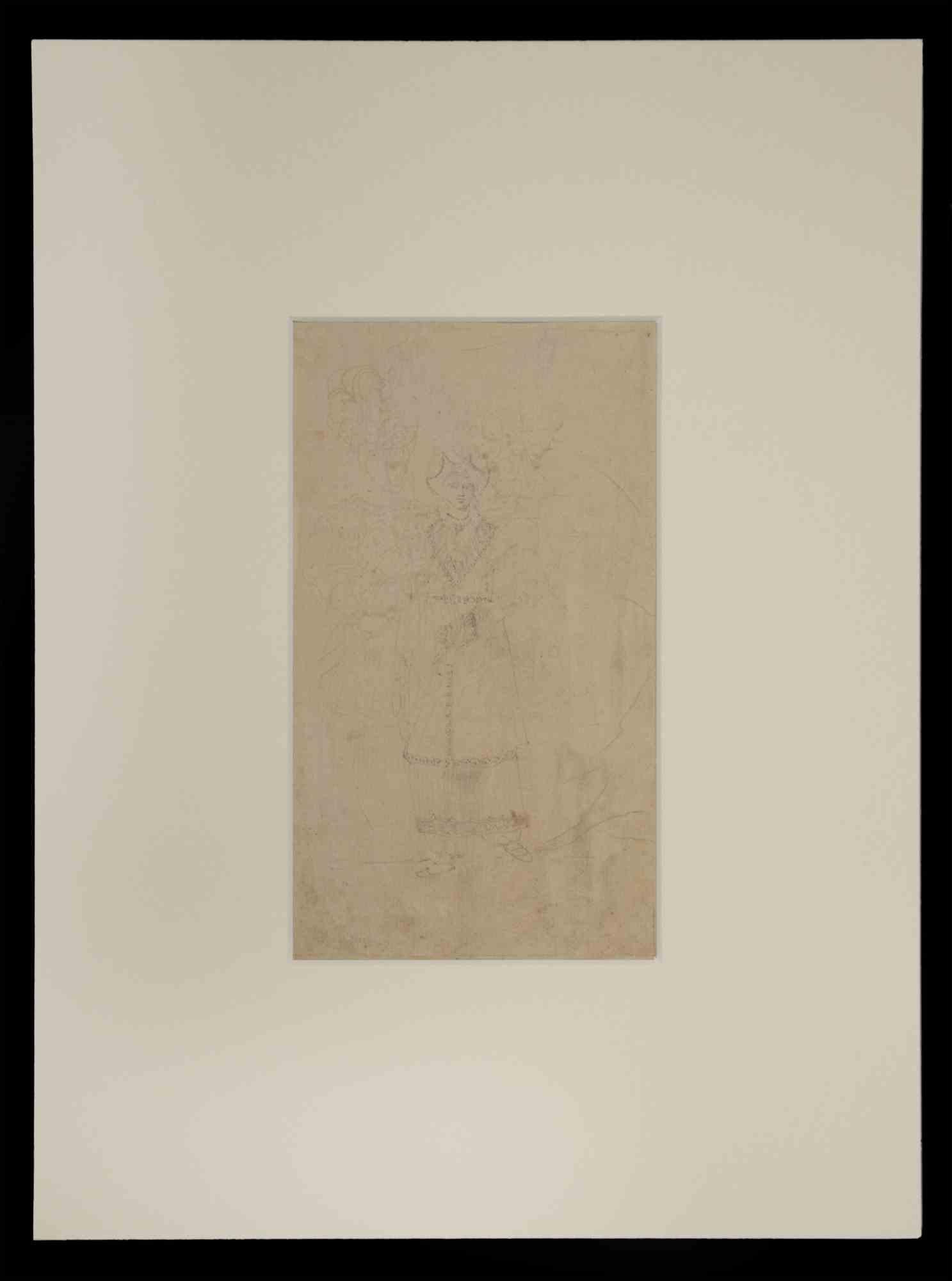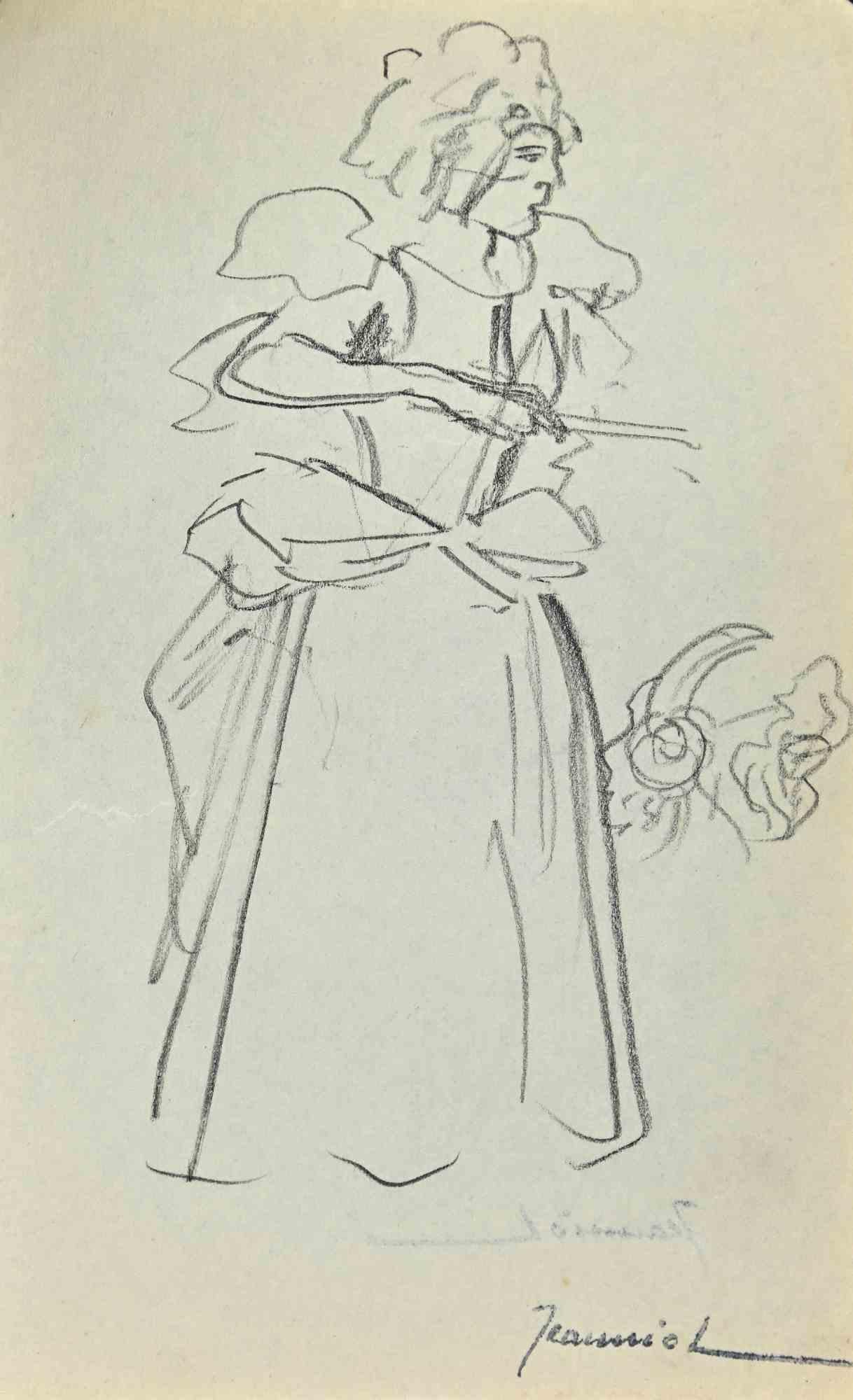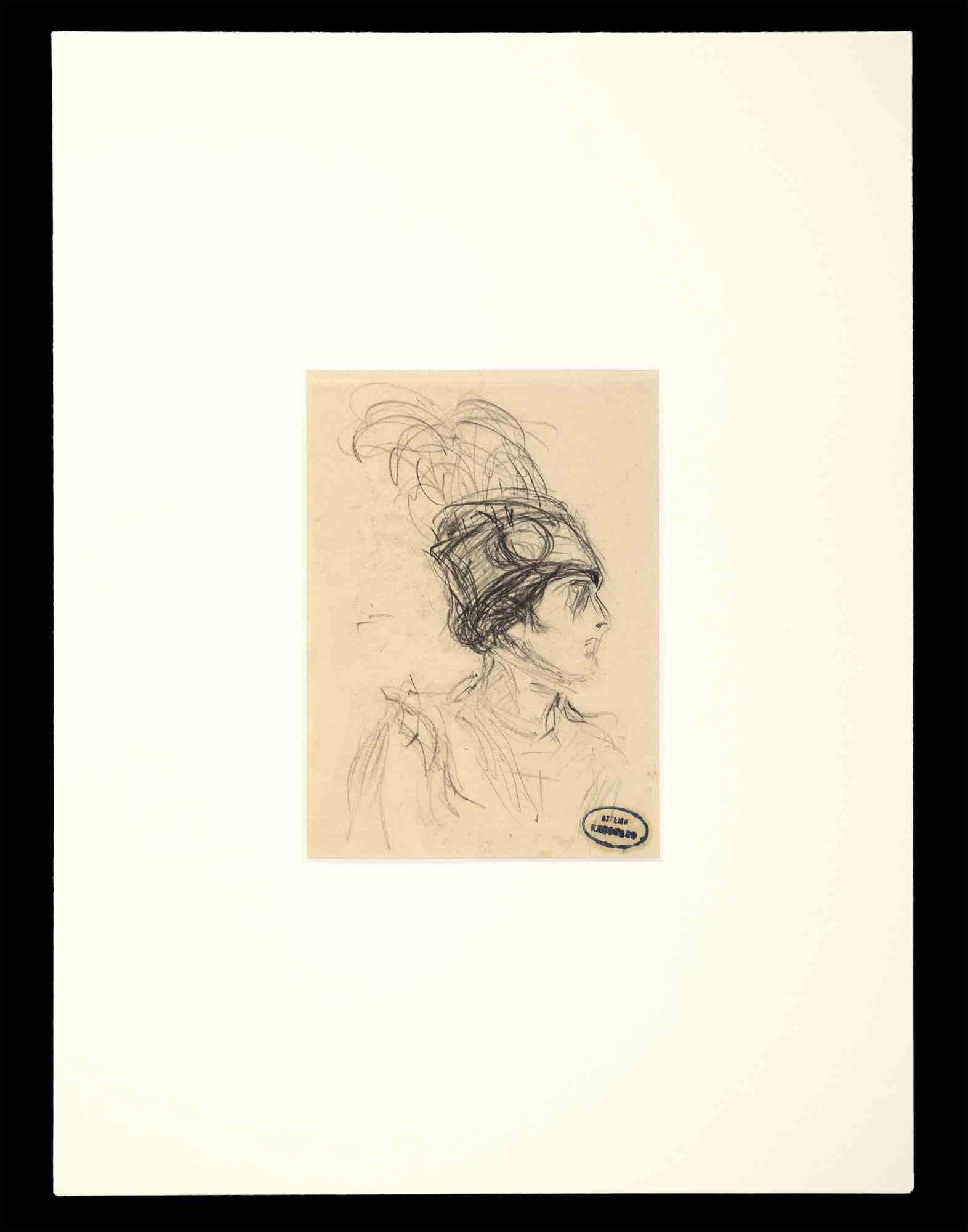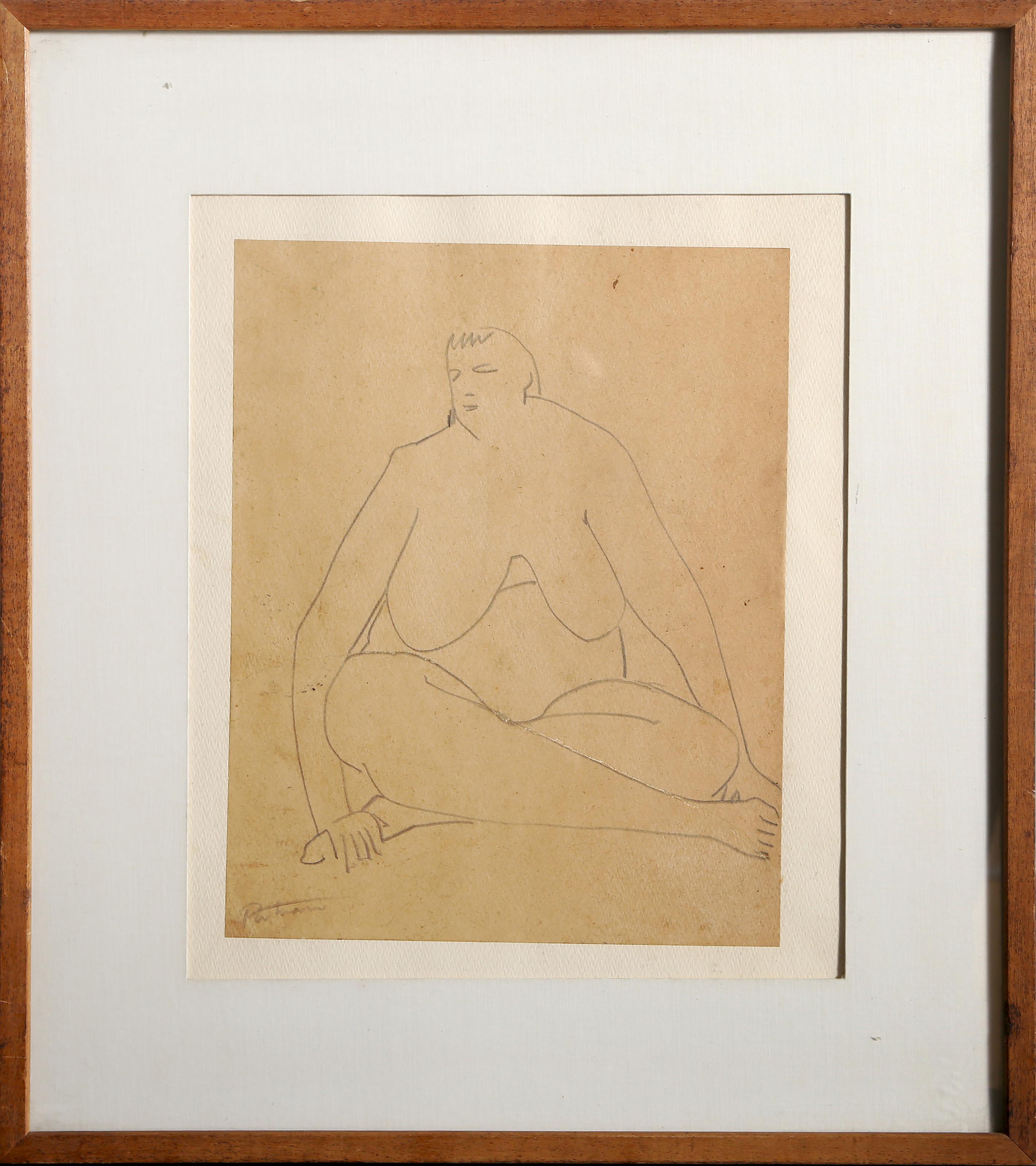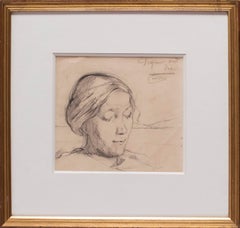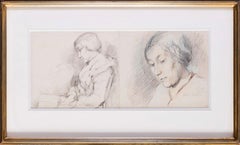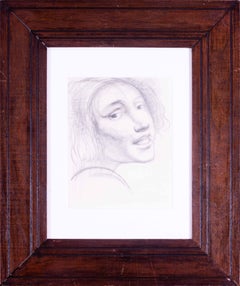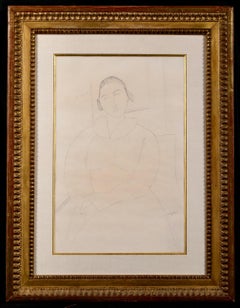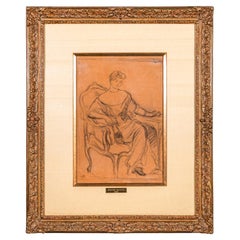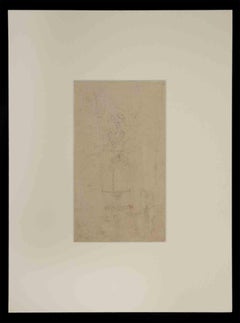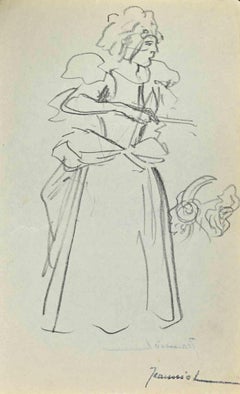Items Similar to Original, signed, Amadeo Modigliani drawing of Mme Anka Zberowska in pencil
Want more images or videos?
Request additional images or videos from the seller
1 of 8
Amadeo ModiglianiOriginal, signed, Amadeo Modigliani drawing of Mme Anka Zberowska in pencil
$41,325.27
£30,000
€35,364.56
CA$56,828.45
A$63,198.74
CHF 33,081.62
MX$770,947.74
NOK 415,682.64
SEK 391,003.19
DKK 263,973.44
About the Item
This is a very exciting and very rare signed drawing by Amadeo Modigliani of Mme Anka Zberowska. Madame Zberwoska was the daughter of a Polish aristocrat who, with her husband, arrived in Paris in 1914. Both became very close to the Amadeo Modigliani, especially as her husband Leo was his main agent. She remained his primary model, until his early death aged only 35. It is likely therefore that this drawing was executed only a few years before his death. Other artists who painted her include Utrillo, Derain and Foujita. Modigliani drawings are both uncommon and highly sought after, so given its excellent Provenance and Literary references this is a rare chance to acquire a work by one of the all time great painters of one of his most well known sitters.
The details of this work are as follows:
Amadeo Modigliani (Italian, 1884-1920)
'Femme Accoudee' Portrait of de Mme Anka Zberowska
pencil on paper laid down on board
signed
16 x 9.3/4 in. (41 x 25 cm.)
Provenance:
Madame Hanka Zborowska (wife of the artist’s dealer); Galerie Zac, Paris; Ronauld Laaren, The Netherlands; Parke-Bernet, New York, 13th May 1964; Bloomsbury Auctions, London, 12th July 2009; Private Collection Guernsey.
Literature:
Oscaldo Patani, Amadeo Modigliani, Catalogue generale; Disegni 1906-1920, Milano 1991. no. 124. Illustrated. A photo-certificate issued by the Wildenstein Institute, Paris was issued for this work.
The primitive style of this Expressionist painter is perhaps best epitomised by the many portraits he painted of Hanka (Anka). Many hang in major art galleries, such as the New York Museum of Modern Art and the Tate gallery.
The full condition report to the work is as follows:
The work has recently been restored to a very high standard. The paper was skilfully removed from various layers of backing paper which endangered the drawing through oxidisation. It has now been expertly cleaned and backed onto acid free paper. There are historical repairs to the corners but the image is so much clearer than it was and the trademark delicate pencil marks can now be seen properly. It is in a bespoke hand finished composite frame of recent construction in perfect condition, behind a peachy coloured mount and gilt slip edge, behind glass.
Little known outside of Paris during his lifetime, Modigliani is now recognized as one of the greatest figurative painters of the early twentieth century. His distinctive nudes and portraits of friends from the vibrant artistic community of Montmartre display his characteristic use of bold contours, long oval faces, and elongated bodies.
Born in Italy to Jewish parents, Modigliani moved to Paris in 1906, where he joined the vibrant artistic community of Montmartre. There, he met artists Pablo Picasso and Constantin Brancusi, who were pushing forward new modernist forms of art-making and appropriating the formal qualities of African art then circulating in Paris. The reductive nature of Modigliani’s compositions owes to both of these influences and to the artist’s admiration for classical Italian Renaissance painting, which he learned about as an art student in Florence and Venice.
- Creator:Amadeo Modigliani (1884 - 1920, Italian)
- Dimensions:Height: 16 in (40.64 cm)Width: 9.75 in (24.77 cm)Depth: 1 in (2.54 cm)
- Medium:
- Movement & Style:
- Period:
- Condition:The work has recently been restored to a very high standard. The paper was skilfully removed from various layers of backing paper which endangered the drawing through oxidisation. It has now been expertly cleaned and backed onto acid free paper.
- Gallery Location:Petworth, GB
- Reference Number:1stDibs: LU540314029552
About the Seller
4.9
Platinum Seller
Premium sellers with a 4.7+ rating and 24-hour response times
Established in 2010
1stDibs seller since 2017
272 sales on 1stDibs
Typical response time: 3 hours
- ShippingRetrieving quote...Shipping from: Petworth, United Kingdom
- Return Policy
Authenticity Guarantee
In the unlikely event there’s an issue with an item’s authenticity, contact us within 1 year for a full refund. DetailsMoney-Back Guarantee
If your item is not as described, is damaged in transit, or does not arrive, contact us within 7 days for a full refund. Details24-Hour Cancellation
You have a 24-hour grace period in which to reconsider your purchase, with no questions asked.Vetted Professional Sellers
Our world-class sellers must adhere to strict standards for service and quality, maintaining the integrity of our listings.Price-Match Guarantee
If you find that a seller listed the same item for a lower price elsewhere, we’ll match it.Trusted Global Delivery
Our best-in-class carrier network provides specialized shipping options worldwide, including custom delivery.More From This Seller
View AllMarie Laurencin portrait drawing of her mother, 1903
By Marie Laurencin
Located in Petworth, West Sussex
Marie Laurencin (French, 1885 – 1956)
Portrait of Pauline Laurencin, the artist’s mother, circa 1903
Black crayon on paper
Inscribed ‘Despair and die / not die’ (upper right)
6.5/8 x...
Category
Early 20th Century Post-Impressionist Portrait Drawings and Watercolors
Materials
Paper, Crayon
1903 portrait drawing by Marie Laurencin of her mother
By Marie Laurencin
Located in Petworth, West Sussex
Marie Laurencin (French, 1885 – 1956)
Portraits of Pauline Laurencin, the artist’s mother with a further study of a child on the reverse
Pencil and pastel on paper
Signed and dated ‘...
Category
Early 20th Century Post-Impressionist Portrait Drawings and Watercolors
Materials
Paper, Pastel, Pencil
Giovanni Boldini drawing of a lady, Italian 19th Century
By Giovanni Boldini
Located in Petworth, West Sussex
Giovanni Boldini (Italian, 1842-1931)
Etude de femme au ruban noir
Signed with atelier stamp (lower left), further inscribed, signed and dated by Emilia Boldini (the artist’s wife) `no 77 le_ atelier Boldini. Emilia Boldini Carbona 1931’ (on the reverse)
Black crayon on paper
11.7/8 x 8.7/8 in. (30 x 22.5 cm.)
Emilia’s inscription on the reverse from the year of his death.
Giovanni Boldini was an Italian genre and portrait painter who lived and worked in Paris for most of his career. According to Time magazine, he was known as the "Master of Swish" because of his flowing style, exemplified by the confident strokes in this fine example.
Boldini was born in Ferrara, the son of a painter of religious subjects, and in 1862 went to Florence for six years to study and pursue painting. He only infrequently attended classes at the Academy of Fine Arts, but in Florence, met other realist painters known as the Macchiaioli, who were Italian precursors to Impressionism. Their influence is seen in Boldini's landscapes which show his spontaneous response to nature, although it is for his portraits that he became best known.
Moving to London, Boldini attained success as a portraitist, painting notable members of society including Lady Holland and the Duchess of Westminster...
Category
Early 20th Century Impressionist Portrait Drawings and Watercolors
Materials
Paper, Crayon
British 20th Century charcoal on paper drawing of a head study of a young girl
Located in Petworth, West Sussex
Elsie Mariam Henderson (British, 1880-1967)
A head study of a smiling girl
Charcoal on paper
9.3/8 x 7.1/2 in. (23.7 x 19 cm.)
Provenance: From the artist’s estate and thence by descent
Collection of Elsie Mariam Henderson, Baroness de Coudenhove
Elsie Marian Henderson was born in Eastbourne in Sussex and with the encouragement of her mother, a keen amateur painter, she attended the South Kensington Schools before studying at the Slade School of Fine Art between 1903 and 1905. She continued her art education in Paris and in 1916, after returning to London she enrolled at the Chelsea Polytechnic, where she was taught lithography by the artist Francis Ernest Jackson...
Category
20th Century Art Deco Figurative Drawings and Watercolors
Materials
Paper, Charcoal
19th Century drawing attributed to John Flaxman of a classical maiden
By John Flaxman
Located in Petworth, West Sussex
Attributed to John Flaxman (British, 1755- 1826)
Study of a classical maiden
Pen and ink on paper
5.1/2 x 3.1/8 in. (14 x 8 cm.)
Category
19th Century Academic Figurative Drawings and Watercolors
Materials
Paper, Ink, Pen
Sir Stanley Spencer 'Portrait of Hilda, Stanley's wife', 1924, drawing
By Stanley Spencer
Located in Petworth, West Sussex
Sir Stanley Spencer, CBE RA (British, 1891 – 1959)
A Portrait of Hilda, the artist’s wife
Pencil on paper
Signed and dated ‘Stanley spencer 1924’ (lower right)
8 x 9.3/4 in. (20.3 x ...
Category
20th Century Academic Portrait Drawings and Watercolors
Materials
Paper, Pencil
You May Also Like
Portrait of Berthe Lipchitz - Modern Portrait Pencil Drawing - Amedeo Modigliani
By Amedeo Modigliani
Located in Marlow, Buckinghamshire
Signed pencil on paper portrait drawing by Italian artist Amedeo Clemente Modigliani. The portrait is of Berthe Lipchitz who was the wife of Modigliani's friend, the sculptor Jacques Lipchitz. This work is a study for "Portrait of Jacques & Berthe Lipchitz" which hangs in the Art Institute of Chicago.
Signature:
Signed lower right
Dimensions:
Framed: 26.75"x18.25"
Unframed: 18.75"x12.25"
Provenance:
The collection of Leopold Survage
The collection of Dimitri Snegaroff
The collection of Leopold Zborowski
Galerie Charpentier - Paris 1958
Private french collection
Galerie Pierre Levy - Paris
Private collection - United Kingdom
Exhibited:
Galerie Charpentier - Cent Tableaux de Modigliani - Paris, 1958
Les Peintres de Zborowski - ~Foundation L'Hermitage, Lausanne 1994
Amedeo Modigliani Exhibition - Museo d'Arte Moderna, Lugano 1999
Amedeo Modigliani was born into a middle-class Jewish family and was the brother of Eugenio Modigliani, who later became the leader of the Italian socialist workers’ party prior to the rise of fascism. Modigliani suffered from poor health as a child and contracted pleurisy in 1895, followed in 1898 by typhus with pulmonary complications, which culminated in tuberculosis in 1901. He moved to Livorno to study under Guglielmo Micheli, who had himself been a pupil of Giovanni Fattori, one of the Macchiaioli group of painters who worked in strong colour patches (macchie) to achieve vivid light and colour effects; their approach came as a reaction against academic art in Italy and, in much the same way as the French Impressionists, they advocated painting from nature rather than aspiring to communicate any particular message or ideology. In 1902, Modigliani enrolled at the academy of fine arts in Florence. He travelled to Rome and Venice in 1903, where he devoted the bulk of his day to visiting museums. At around this time he started to read Dante, dreaming no doubt of the Vita Nuova; he also devoured the works of Leopardi, Carducci, d’Annunzio, Spinoza and Nietzsche.
In 1906, Modigliani moved to Paris, lodging at the Rue Caulaincourt. At that juncture, nothing about him appeared to presage the brilliant career that was to follow. His arrival in the artists’ quarter, then known colloquially as the maquis - the labyrinthine tangle of narrow streets around today’s Avenue Junot in Montmartre - went virtually unnoticed by the artists already living and working there, including Picasso, Braque and Derain. Modigliani’s painting made next to no immediate impact and he was recognised primarily on account of his frail constitution, flashing eyes, innate elegance and intellectual prowess. He was accepted in the community that was Montmartre but never belonged to any particular ‘set’ or circle, and there is no record of his ever having been invited to Pablo Picasso’s studio, the famous ‘wash house’.
The literate and highly articulate Modigliani opted instead for the companionship of Maurice Utrillo, an instinctual painter of whom it could charitably have been said that his conversation was, at best, limited. Nonetheless, Modigliani and ‘Litrillo’ (as Utrillo was commonly known to the street urchins - the ‘p’tits poulbots’) began to frequent the cabarets and dance halls of the Butte de Montmartre, and the nefarious hashish dens - post-Baudelaire ‘institutions’, frequented in the main by out-of-work writers and talentless artists. Modigliani developed an addiction, which, compounded by his alcoholism, took its toll. It also transformed him from an artist of limited ability into one devoid of bourgeois scruples.
In his monograph, Modigliani: Sa Vie et Son Oeuvre, written in 1926 shortly after Modigliani’s death, André Salmon hinted at a ‘pact with the devil’. While somewhat overstating the case, this rather unpromising painter from Livorno metamorphosed virtually overnight into an artist of rare ability and sensitivity. The turning-point came in 1907, when Modigliani met Paul Alexandre, a doctor who befriended him, took him under his wing and purchased some of his work. The banal paintings he had turned out in Montmartre were suddenly superseded by exceptional works, produced first in Montmartre ( Cellist, 1909), and then in Montparnasse.
In Montparnasse, Modigliani started to move in artistic circles, meeting Chaim Soutine, Marc Chagall, Jules Pascin and others, all of whom lived and worked in the building in the Rue Vaugirard known as ‘La Ruche’ (‘the beehive’). Then, in the Cité Falguière, he met the Romanian-born sculptor Constantin Brancusi, who encouraged him to take up sculpture, which he did, between 1909 and 1913. In 1914, several dealers, including the erstwhile poet Léopold Zborowski and the collector Paul Guillaume, tried with little success to market Modigliani’s paintings. From 1914 to 1916, Modigliani was caught up in a tempestuous affair with the English poet and journalist Beatrice Hastings. In 1917, however, he met Jeanne Hébuterne at the Colarossi Academy, who became his constant companion and model, and who gave birth to their daughter Jeanne in 1918. In 1918 and 1919, Modigliani and Jeanne spent time in Nice on the Côte d’Azur but by 1920 he was suffering from tubercular meningitis. His friends, Kisling and the Chilean Ortiz de Zarate, brought him and a pregnant Jeanne back to Paris, where he died on January 20 1920 in the Hôpital de la Charité. His last words were reputed to be: ‘Cara Italia’. Modigliani’s brother, by this time a socialist member of parliament, telegrammed instructions to ‘bury him as befits a prince’. Jeanne Hébuterne, a budding twenty-year-old painter, killed herself and her unborn child on the day of Modigliani’s funeral by jumping to her death from a fifth-floor window.
Modigliani’s first paintings were undistinguished portraits in the Impressionist manner. After moving to Paris in 1907, his early work was influenced by the Swiss-born lithographer Théophile Alexandre Steinlen, Henri de Toulouse-Lautrec and Pablo Picasso, the latter then in his ‘blue’ period. From the onset, Modigliani’s principal preoccupation was the human figure. After the artistic (and literal) limbo of Montmartre, when his output was confined to a few Expressionist-like paintings of street life, the theatre and the circus, Modigliani suddenly erupted on the scene in 1909 with Cellist, a robust, well-constructed and vividly coloured canvas that utterly exceeded all prior expectations. He had not taken part in the protracted debates that took place nightly in Picasso’s studio, but he had superficially assimilated the Cubist ideas developed by Picasso and Georges Braque. Above all, Modigliani had been influenced by African art, which was a key feature of the Cubist movement. He succeeded in treading a fine line between the coolly analytical Cubist approach and the all-too-common European perception of African art as a succession of exaggerated facial grimaces.
It would appear that Modigliani had always been attracted to sculpture as a discipline. The friendly encouragement he received as of 1909 from Brancusi no doubt intensified his interest and reinforced his attempts to achieve a sustained simplicity of line and form. In 1910, he befriended the Russian artists Alexander Archipenko and Jacques Lipchitz, both of whom recorded Modigliani’s distaste for modelling in clay (which he referred to as ‘mud’), on the grounds that it degraded the art of sculpture. Like Brancusi, Modigliani believed in working directly, carving from wood in the case of two extant pieces, and from (sand)stone in others, with the exception of a few bronzes which were, presumably, modelled in clay before being cast into bronze. His sculpture was influenced by archaic and non-western cultures - early Graeco-Roman, African and Khmer - as well as heads carved on columns adorning the façades of Romanesque and Gothic cathedrals (Modigliani rarely sculpted a rear view of his figures). Up to approximately 1912, his sculptures take the form of tall cylinders, usually with elongated heads and shallow relief indentations or projections to indicate the hairline, facial features and neck. He departed from this style only infrequently, most notably in a small number of pieces believed to have been sculpted in 1913, which are characterised by a compressed, cubistic format and shallower and less distinct features. Modigliani eventually abandoned sculpture, presumably because of his general health and circumstances, and possibly due to the fact that his sculptures sold for even less than his paintings. During the years that he devoted to sculpture, Modigliani is recorded as producing only thirty canvases, although after 1913 his sculpture became reflected in his painting.
Following his Montmartre days, Modigliani’s work developed in both quantitative and qualitative terms, presumably helped by the relative stability of his relationship with Jeanne Hébuterne. The first paintings after his short-lived sculptural phase saw him revert briefly to Neo-Impressionist pointillism, followed by a episode marked by Cubism, which was mainly evident in portraits of friends and fellow artists living and working in Montparnasse: Henri Laurens; Juan Gris (1915); Jacques Lipchitz and his Wife; Chaim Soutine; Léopold Sauvage; Paul Guillaume; Max Jacob; Béatrice Hastings con Capello (all 1916); Mlle Modigliani (1917); Léon Bakst; Léopold Zborowski; Concierge’s Son; Adolescent (1918); Mademoiselle Lunia Czechowska; Madame Zborowska; Portrait of the Artist’s Wife (1919). A large number of other portraits exist among his drawings, most of which were executed impromptu in the street or cafés. These quickly drawn portraits often exhibit an urgency and surprising lucidity. Examples include Portrait of the Gypsy Painter Fabiano de Castro; André Salmon (1918); Portrait of the Artist’s Wife (1919); and Lada, Author; Mario, Composer (1920).
Whatever his shortcomings, Amedeo Modigliani ranks as one of the 20th-century’s greatest painters of the female form. The bulk of his painted nudes were produced in 1915-1916 (prior to that date they were predominantly drawings), and are taken from every walk of life, such as a regular at a Montparnasse café, or a waitress at the soup kitchen where he ate his meagre meals. In each instance, he invested his models with an almost aristocratic hauteur. This is exemplified in a number of paintings (usually based on numerous prior drawings): Flower Girl; Blonde Lady; Sleeping Nude (1917); Blonde Nude; Young Woman; Maria (1918); Pink Nude; Reclining Nude; Nude on a Divan; Woman with a Fan (1919); and Young Woman in a Chemise; Reclining Nude (1920). Modigliani painted his subjects in elongated, elliptic ovals: the swell of a breast, the pronounced curve of the pelvis, the fullness of the thigh, the symmetrically oval face and the graceful arabesque of the body. Facial features are reduced to a bare minimum, with the eyes typically empty, like those of a statue. He employed colour as a constructive material in much the same way as stone in sculpture, juxtaposing muted pinks, ochres and pale browns against discreet background tones supplied by décor and garments. The overall effect is to yield a flat image devoid of chiaroscuro but which captures the essence of a subject. It has often been remarked that his women, with their elongated heads and long, graceful necks, generally tilted to one side, possess a melancholy beauty akin to that of the Siena Madonnas (reproductions of which Modigliani kept pinned on his studio wall), which accounts for Modigliani’s soubriquet as the ‘painter of sorrows’. From 1917, the majority of his nudes, characterised by a more pronounced elongation of the female body and lighter palette, were modelled by Jeanne Hébuterne and Luna Czechowska.
Very few artists have been the subject of so many monographs and biographies as Modigliani; the selection appended to this entry indicates only some of the more important of these. Too much, perhaps, has been made of his life as an artiste maudit, of his ‘accursed’ yet colourful life rather than the quality of his work. Some critics have detected in him an artist of great and persistent intellectual curiosity; others emphasise that he was a ‘gentleman to the end’ and stress his physical frailty, ignoring the fact that this was an integral component of his creativity. More seriously, his posthumous fame amongst the public at large acts both for and against him, as if his subsequent popularity has become a yardstick of his artistic ability. The mannerism of his style ensures that a ‘Modigliani’ is instantly recognisable, but his success in adapting Cubism and African art to a language and palette that are entirely his own places him squarely at the heart of the modern movement.
Amedeo Modigliani’s work has featured in numerous group exhibitions, including: Paris in 1908, when he showed his Jewess and three other canvases; the Salon des Indépendants in 1910; and the Salon d’Automne in 1912, where he exhibited examples of his sculpture. His posthumous inclusion in the 1922 Venice Biennale was regarded in Italy as a complete fiasco, prompting the critic Giovanni Scheiwiller to paraphrase Charles Baudelaire’s remark to the effect that, ‘we know that precious few will understand us, but that shall be sufficient’. In 1917-1918, the Berthe Weill Gallery organised a one-man show at the instigation of Zborowski but, on the order of the then chief of police, some of Modigliani’s sensual nudes were withdrawn on account of alleged indecency. On 20 December 1918, the Paul Guillaume Gallery exhibited several paintings by Modigliani alongside others by Matisse, Picasso and Derain.
All other exhibitions of Modigliani’s work have been held since his death. They include those at the Bernheim-Jeune Gallery in Paris (1922); Galerie Bing (Paris, 1925 and 1927); Marcel Benhelm Gallery (Paris, 1931); Palais des Beaux-Arts (Brussels, 1933); Kunsthalle Basel (1934); American-British Art Center (New York, 1944); Galerie de France (Paris, 1945 and 1949); Gimpels Fils Gallery (London, 1947); Cleveland Museum of Art (1951); Museum of Modern Art (New York, 1951); Cantini Museum (Marseilles, 1958); Palazzo Reale (Milan, 1958); Galerie Charpentier (Paris, 1958); Chicago Arts Club (1959); Cincinnati Art Museum (1959); Galleria Nazionale d’Arte Moderna (Rome, 1959); Boston Museum of Fine Arts (1961); Perls Galleries (New York, 1963 and 1966); Kyoto National Museum of Modern Art (1968); Musée Jacquemart-André (Paris, 1970); Musée St-Georges (Liège, 1980); Tokyo Arts Centre (1980); Musée de l’Art Moderne de la Ville de Paris (1970; a comprehensive exhibition of Modigliani’s sculptures...
Category
1910s Modern Portrait Drawings and Watercolors
Materials
Paper, Pencil
Price Upon Request
Free Shipping
Pierre-Auguste Renoir Madame de Galéa Signed Original Sketch Graphite on Paper
By Pierre-Auguste Renoir
Located in Keego Harbor, MI
A lovely impressionist portrait graphite drawing on paper titled “Madame de Galéa” by Pierre-Auguste Renoir. Hand signed “R” on the bottom left. Created circa 1900s. On the verso it is inscribed “Study for Painting. Exhibition at Detroit Institute of Arts.” Renoir painted several portraits of Madame Madeleine de Galéa, and Renoir’s 1915 painting...
Category
Antique Early 1900s Drawings
Materials
Paper
Portrait of Woman - Original Drawing - 19th Century
Located in Roma, IT
Portrait of Woman is an original drawing in Pencil realized by an unknown Artist in the 19th Century.
Good Conditions.
The artwork is depicted through soft strokes in a well-balanc...
Category
Late 19th Century Modern Figurative Drawings and Watercolors
Materials
Pencil
Woman - Pencil Drawing By Pierre Georges Jeanniot - Late 19th Century
By Pierre Georges Jeanniot
Located in Roma, IT
Woman is an Original Pencil Drawing realized by Pierre Georges Jeanniot (1848-1934).
Hand-Signed and some notes by the artist on the lower left corner.
Good condition.
Pierre-Geo...
Category
Late 19th Century Modern Figurative Drawings and Watercolors
Materials
Pencil
Portrait of Woman - Original Drawing - early 20th Century
Located in Roma, IT
Portrait of Woman is an original drawing in Pencil by an anonymous artist in the early 20th Century.
Good Conditions.
The artwork is depicted through soft strokes in a well-balance...
Category
Early 20th Century Modern Figurative Drawings and Watercolors
Materials
Pencil
Portrait of a Woman, Modern Graphite Drawing by Wallace Putnam
Located in Long Island City, NY
Wallace Putnam, American (1899 -1989) - Portrait of a Woman, Year: circa 1960, Medium: Graphite on Paper, signed in pencil lower left, Image Size: 10 x 8.5 inches, Size: 13 x 10 ...
Category
1960s Modern Nude Drawings and Watercolors
Materials
Graphite
More Ways To Browse
Portraits In Pencil
Drawing Of Venice
Vintage Face Drawing
After Modigliani
Pablo Picasso Pencil Drawing
Modigliani Portrait
Oval Italian Painting
Netherlands Painting Early 20th Century
Aristocrat Painting
Bloomsbury Painting
Brancusi Portrait
Guernsey Glass
24x24 Painting
Pink Paintings
Antique Prints And Engravings
Modern Paintings French Artists
French Impressionist Art
Chicago Artists

